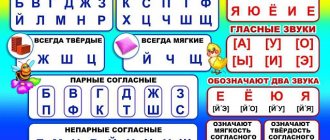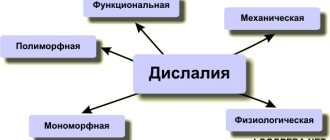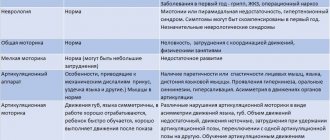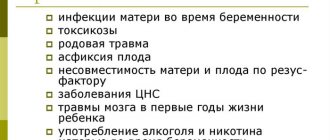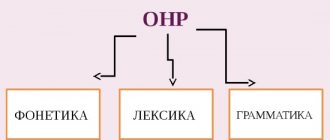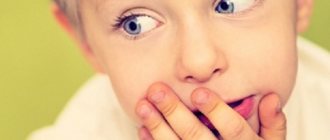Dyslalia is a disorder of sound pronunciation in children with normal hearing and intact innervation of the articulatory apparatus. With dyslalia, there may be a violation and difficulty in pronouncing any phonemes of the child’s native language.
Dyslalia is characterized by replacement, confusion, distortion or absence of sounds in the child’s oral speech. Diagnosis of dyslalia involves a speech therapy examination of the structure and mobility of the speech apparatus, as well as diagnosis of the state of current sound pronunciation and phonemic hearing. In some cases, consultation with highly specialized specialists (dentist, neurologist, otolaryngologist) is necessary.
The causes of this speech disorder can be organic, hereditary, congenital or acquired factors.
Types of dyslalia
Dyslalia, as a form of speech pathology in children, has various types and forms. The classification depends on the reasons for which the sound pronunciation disorder occurs. Experts distinguish two forms of dyslalia: mechanical and functional.
Mechanical (organic) dyslalia is a form of speech pathology caused by the presence of defects in the structure of the articulatory apparatus.
The causes of functional dyslalia, in contrast to mechanical dyslalia, are associated either with social factors or with reversible neurodynamic disorders in the cerebral cortex.
Functional dyslalia has the following varieties:
- motor dyslalia: this pathology is characterized by imprecise and undifferentiated movements of the tongue and lips, which causes phonetic defects (distortion of sounds);
- sensory dyslalia: with this disorder, auditory differentiation of acoustically similar sounds (hard/soft, dull/voiced, etc.) is difficult, causing the child to mix and replace sounds in oral speech.
In addition, there are cases when experts identify the presence of sensory and motor speech insufficiency; this type of disorder is called “sensorimotor dyslalia.”
The lack of formation of certain signs of sounds and the nature of the speech defect allow us to distinguish the following types of dyslalia:
1. Phonemic dyslalia - the cause of this type of dyslalia is the immaturity of the operations of selecting sounds according to their articulatory characteristics. With this form of dyslalia, the articulatory base may or may not be fully formed. In the first case, the child simply selects the sounds incorrectly; the second option assumes that in the absence of the desired sound, the child replaces it with a simpler phoneme.
2. Phonetic dyslalia - the occurrence of this form of dyslalia is associated with the formation of incorrect articulatory positions. Such a speech disorder manifests itself in the fact that the child pronounces a sound that does not exist in the phonetic system of the language.
Taking into account the number of disrupted sounds, the following types of violations can be distinguished:
- simple dyslalia (monomorphic dyslalia) - characterized by incorrect pronunciation of one sound or several sounds from one group;
- complex dyslalia (or “erased” dyslalia, or polymorphic dyslalia) - characterized by incorrect pronunciation of several sounds from different groups.
Experts also distinguish physiological dyslalia (or age-related), which is characterized by disturbances in sound pronunciation up to 5 years of age, caused by insufficient development of the organs of articulation. This speech disorder goes away on its own after 5 years.
Sound pronunciation with dyslalia
Sound pronunciation with dyslalia is impaired in different ways. It all depends on the type of dyslalia. A large number of children suffer from deficiencies in sound pronunciation. In a small proportion of children, the disorders gradually smooth out with age. Physiological dyslalia ( physiological tongue-tiedness ) is registered in them In most children, dyslalia requires very serious complex treatment. In these cases, dyslalia manifests itself as an independent disease, an independent speech disorder. Dyslalia very often precedes diseases such as stuttering, general speech underdevelopment (GSD), dysgraphia, agraphia, and dyslexia.
Causes of dyslalia
The occurrence of speech impairment in a child can be due to a number of reasons. Somatic causes include physical and neurological weakness (due to long-term chronic diseases).
Mechanical dyslalia, as a rule, occurs due to organic or congenital defects of the articulatory apparatus (tongue, lips, teeth, jaws).
Social reasons (with functional dyslalia) for the occurrence of speech disorders are as follows:
- bilingualism (bilingualism in the family - in this case, the child inserts elements of one language into another);
- the child imitates the incorrect speech of adults (uses dialects, is in a hurry);
- adults, when communicating with a child, imitate baby babble (“lisp”);
- pedagogical neglect (parents do not correct deficiencies in their children’s speech and do not demonstrate examples of correct sound pronunciation).
In addition, factors such as:
- choice of incorrect articulation;
- underdevelopment of phonemic hearing (while physical hearing can be preserved).
Rotacism
This is a violation of the pronunciation of the sounds “R” and “R”. Rhotacism is very common due to the articulatory difficulty of pronunciation. Babies have a regular "R" sound in their babble. But children begin to pronounce a real, pure “R” after 2 years. Articulatory preparedness plays a role here. Normally, the respiratory stream flows through the center of the tongue, the tip of which vibrates, the side edges are pressed against the upper outer teeth.
In case of deviation from the norm, the following are distinguished:
- Lateral rhotacism - one edge of the tongue does not adhere to the upper molars. There is a squelching shade - an average between "r" and "l"
- Guttural rotacism - the activity of the root of the tongue is impaired
- Velar rhotacism - vibration occurs when the root of the tongue approaches the boundaries of the hard and soft palate
- Uvular rotacism - the small tongue of the uvulus vibrates.
- Rolling – forced use of the tongue
- Single-stroke or fricative - pronouncing the English sound “r”
- Kucherskoe “r” is a back-lingual sound like the English “r”.
Dyslalia examination
Diagnosis of speech with dyslalia in children begins with collecting the following data:
- features of the course of pregnancy and childbirth in the mother;
- a list of diseases suffered by the child;
- whether there is early psychomotor and speech development;
- the condition of the child’s hearing, vision and musculoskeletal system.
After collecting the necessary information, the speech therapist proceeds to study the structure and mobility of the organs of the articulatory apparatus (visual inspection and assessment of the performance of a series of imitation exercises).
Diagnostics of oral speech at the First Children's Medical Center includes examination of the state of sound pronunciation and identification of incorrectly pronounced sounds. A speech therapy examination for this speech pathology makes it possible to identify the nature of the disorder in various positions, words, phrases, and texts.
How to treat dyslalia and get rid of tongue-tiedness?
At the first consultation, the doctor will tell you how to treat dyslalia in Saratov in preschoolers and schoolchildren, how to cure dyslalia in Russia in children of preschool and school age, how to get rid of tongue-tiedness , what is articulatory phonemic, articulatory phonemic and phonetic, motor and sensory, mechanical, monomorphic, phonemic, simple, complex dyslalia in preschool children. How is prevention, correction of dyslalia , speech therapy examination of children with dyslalia carried out? Does speech therapy psycho-correctional pedagogical communication work help? How does sound pronunciation suffer with dyslalia? Why is polymorphic dyslalia dangerous, what is cheiloplasty, uranoplasty? What is the etiology and causes of dyslalia, differential diagnosis, exercises, gymnastics, literature, conclusion? What is rhinolalia, dysarthria, FNR, FFN, speech card? What is the prevention of dyslalia ? Sarklinik knows how to treat dyslalia in children in Russia.
Sarclinic provides treatment for aphonia, dysphonia, bradylalia, treatment of stuttering, tachylalia, open and closed rhinolalia, dyslalia, treatment of alalia, dysarthria, treatment of aphasia, nasalization, treatment of speech delay, dysgraphia, treatment of general speech underdevelopment, hyperkinesis, synkenesia, treatment of speech development disorders, SPD, delays in speech and psycho-speech development, dyslexia in children and adolescents in Saratov.
Sign up for a consultation. There are contraindications. Specialist consultation is required.
Text: ® Sarclinic.com \ Ssrlinic.ru Photo: (©) (©) Gekaskr | Dreamstime.com \ Dreamstock.ru The children depicted in the photo are models, do not suffer from the diseases described and/or all coincidences are excluded.
Related posts:
Yactation, rocking, nodding movements of the head, torso, body
ADHD in children: treatment, attention deficit hyperactivity disorder
Depression in adolescents, children, treatment of depression in Saratov
Delay, mental development disorder of the child, children with mental retardation
General speech underdevelopment in children, phonemic onset: levels, correction, treatment
Comments ()
Correction and elimination of dyslalia
Methods for eliminating dyslalia depend on the form and type of disorder and include:
- work aimed at eliminating anatomical defects (with mechanical dyslalia);
- articulation gymnastics;
- speech therapy massage;
- individual lessons with a speech therapist.
Specialists at the First Children's Medical Center determine the treatment method individually for each little patient. All classes with a speech therapist are aimed at developing the baby’s speech motor skills, as well as the development of phonemic processes.
Please note that speech therapy sessions for the correction of dyslalia should be conducted on a regular basis. In addition, to achieve a positive result, it is important to complete the speech therapist’s tasks at home and do articulatory gymnastics.
By contacting our Center, you will receive qualified help from a speech therapist who will pay special attention to your child and give answers to all your questions. We are happy to help you! First Children's Medical Center: Children's health - parents' peace of mind!
Share on social networks:
To make an appointment with a doctor
Choose a doctor
Types of Pronunciation Disorders
Violations of sound pronunciation can be of the type of distortion, confusion or replacement. Distortion –
the process of irregular pronunciation of a sound in all positions in a word due to the lack of formation of the correct articulatory position. Speech sounds acquire a sound that is unusual for the native language: the sound [s] can be hissing, [ts] can be wheezing.
Mixing
- a process when a child has well-formed and practiced all articulatory positions, but he does not know how to distinguish some of these positions, so the pronunciation of sounds is mixed, the same word can have different sounds.
Replacement
– a condition when a child confuses sounds that are the same in the method of formation, but different in the place of articulation, or vice versa. He also replaces hard consonants with soft ones, whistling ones with hissing ones, instead of [w] he says [s], instead of [zh] - [z], instead of [r] - [l].
Substitutions and mixing of sounds occur for the following reasons:
– acoustic-phonemic – the child does not fully hear the sound, cannot recognize it in the sensory level, and then it is difficult for him to process it into the correct pronunciation. For example, instead of “cat” he says “that”, “goth” - “cat”, etc.
– articulatory-phonemic – the child cannot establish the correct articulatory posture when pronouncing a sound. For example, when pronouncing the sound [s], the lips should be parted in a smile, the teeth should be exactly above each other (“Fence”), there should be a small gap between the teeth, and the tongue should rest against the lower teeth. And the child stretches his lips forward with a tube, so it turns out [s] with a hiss. Due to insufficient development of articulatory positions, the child looks for the easiest and most accessible pose for him. Or another reason: the child has correctly developed all articulation patterns, but he cannot differentiate some sounds. This gives rise to three levels of sound pronunciation impairment:
- Incorrect pronunciation of a sound or group of sounds in different positions, in isolation, in syllables, words and phrases.
- Pronunciation of isolated sounds is correct and incorrect in words, phrases and sentences.
- Correct pronunciation of sounds in words and phrases, but mixing them with other sounds in the flow of speech.
The above levels correspond to three stages of working on sound: staging, automation and differentiation. Substitutions and mixtures most often occur between sounds that differ only in one attribute: whistling and hissing (Shasha-Sasha), plosive front-lingual and back-lingual (Tatya-Katya), hard and soft (bear-mouse), sonorants (Roma-Loma) and etc. Substitutions and confusions are often reflected in written language.

